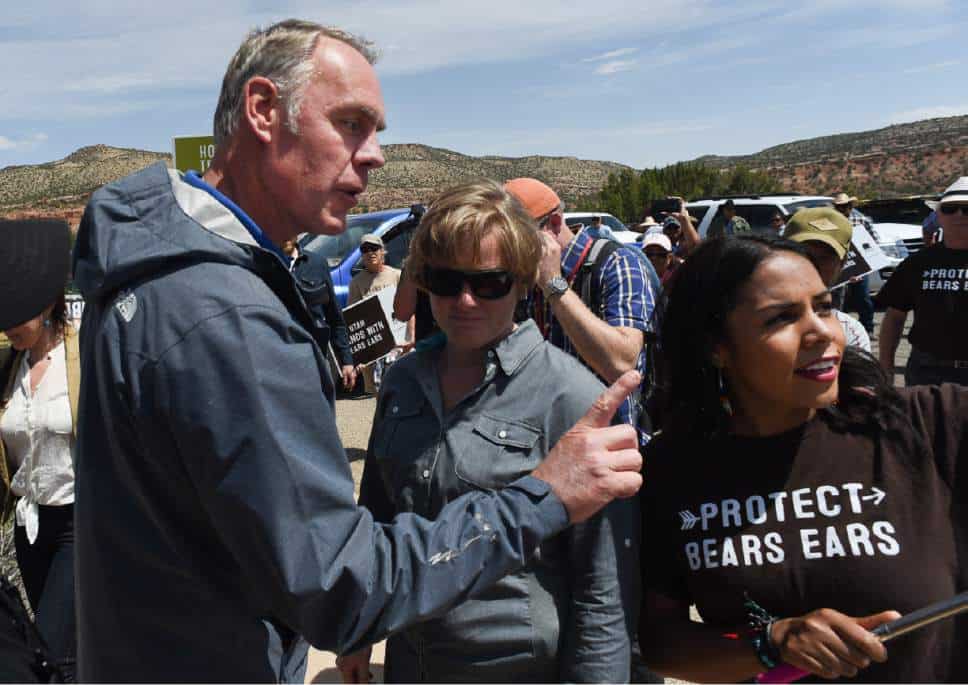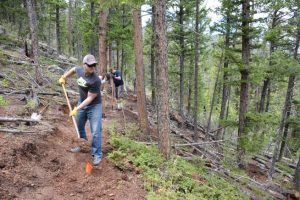I’ll be posting a variety of different things as we play around with different names and website formats. As this process goes forward, please add your comments to the tab above named NCFP Renewal Comments (between “Comment Policy” and “Contributors” above. It makes it easier for me to round them all up. Thanks!
Ryan Zinke’s flag has been taken off the Interior pole: The loyal soldier for Trump’s “energy dominance” agenda had tallied up more than a dozen federal investigations
Lots of news about Secretary Zinke’s resignation today. The self-professed “geologist” was rocked by numerous scandals. As harsh as most all of the news coverage about Zinke’s departure is today, I’m going to say that history will judge Zinke even harsher.
Wayne National Park
I just did this for their headline/picture, but here’s the article about the wilderness planning part of their forest plan revision process.
Blue Mountain Forest Plan Objection Meetings
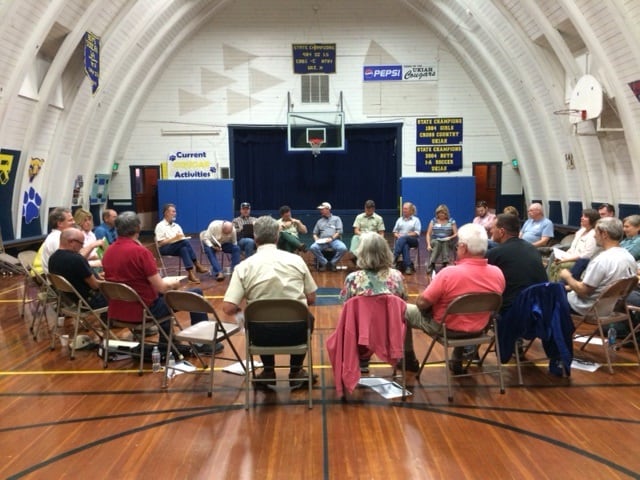
Trouble shooting request: this shows up as upside down on my phone but right side up on my computer. If yours shows up upside down, please let me know what device you are using in the comments. Thanks!
I came across this letter to the editor in the Capital Press. I’m interested in how this is working. What was it like to be involved for objectors? For the FS folks? What is the role of the “team from D.C.?”. I hope that some readers can add their impressions in the comments below.
To every one of you who attend the first set of meetings on the Blue Mountains Forest Plan Revision: Thank you. It was great to see everyone who had traveled from around the West to have their objections heard or to support those who were speaking out about the plan.
I was impressed with the care each of you took to present your objections, but even more, I was awe struck at the control each of you showed in a matter that is very dear to each of our hearts and that impacts our ability to sustain our families in Northeastern Oregon. While open access to our mountains seems to be such a simple concept when it comes to subsistence use, it eludes those that make decisions who have never had to worry about heating their homes with firewood or had to extract food that supplements our families through the winter.
While we saw a solid turn out of objectors in the meetings from Nov. 27th to Dec. 1st, I fear a great deal of those who objected missed out on these first meetings and did not have their voices heard. The team from D.C. stated we would hear back from them sometime at the end of January and we should expect additional meetings sometime in March to see what the next steps would be.
If the meetings are held in March it will be paramount that every objector attend the meetings and participate in the process. I ask each of you that know you are an objector to follow Forest Access For All on Facebook to get current information on the process and how to participate.
These meetings sounded very interesting. Here is the link with the information about them, and here is the link to the reading room for objections. There seem to 353, which would be quite a few objectors to meet with.
Resolution meetings between objectors, interested persons, and Forest Service Reviewing Officers have been scheduled between November 27 and December 1, in five different cities in Eastern Oregon. Meeting locations were identified based on where the majority of Objectors and Interested Persons reside. Invitation letters and meeting agendas were sent to all eligible objectors and interested persons (Review Resolution Meetings Invitation to Objectors and Interested Persons.) Although the meetings are open for public observation, only Objectors and Interested Persons will be invited to actively participate in the resolution meetings.
There is potential for a large number of objectors and interested persons to attend the resolution meetings. To help facilitate productive dialogue between objectors, interested persons, and Reviewing Officials on the main objections issues, there will be multiple, two-hour discussion sessions during each meeting. (See agenda for each meeting, attached to Resolutions Meeting Invitation.) Up to 20 Objectors or Interested Persons will participate with the Reviewing Officers in each discussion session.
NCFP Website Improvement – Feedback From Users Wanted!
Since we need to update the website, this is an opportunity to get all the things fixed that have been troubling us.
Here’s the list I came up with – others are welcome to add their own thoughts.
1. Theme that is supported and friendly with different devices (phones, tablets, computers) and compatible with WordPress 5.0 and our favorite plug-ins.
2. Easy to read (OK, especially for older people)
3. Better searches of content including comments
4. A digest function that works
5. Crowdfunding widget
Other thoughts or requests?
NCFP 10th Year Celebration: Reflections on Identity
We’ve been doing this blog/network/community (BNC) for almost 10 years now. From November 2018 to November 2019 will be our Anniversary Year, a chance for reflection, celebration and renewal. For readers who are more pragmatic, our identity is important because we need to redesign our web presence, as the theme is no longer supported. Our new design should follow from what it is we do. And we’ll need to go looking for funding. So I’m looking to develop an “elevator speech” about what it is we do.
The BNC has changed quite a bit from what we first envisioned: Martin Nie and I talking about the development of the 2012 Planning Rule. Even at that time, our efforts were intended to be more or less forestry extension (in the Land Grant USDA Extension sense) about policy. The idea was to provide a forum in which academics and practitioners, and those who wanted to learn about a topic, could meet and discuss and debate forest policy issues. It started as posts by Martin and I and others, with discussion, but changed and grew over time to a broader focus.
I’ve told the story about getting into various levels of trouble as an employee because what I thought of as Extension, others saw as Public Affairs. If you talk to outsiders about silviculture, that’s a good thing. If you talk to outsiders about planning, that’s not so good. You can see why a person who had come from science (talking to people about your work is a good thing) to planning could have been confused. We were somewhere in an awkward, unexplored interface.
But here we are nine years later, and we are still in this strange and wonderful interface between news reporting, and public/science education or extension. We tend to use news articles as jumping off points for our discussions. In that sense, we are a news-sharing network. But we add value to those articles from our own experiences- or our own exploration of different news stories on the same subject, and speaking directly to the individuals involved in the story to get more information. Which verges on something we might call “supplementing or complementing news stories.”
In addition, our site provides a platform for stories you wouldn’t be likely to otherwise access, and voices you might not otherwise hear from, whether found or requested by us. We’re a bit like the “citizen journalism” movement or maybe we’re crowd-sourced journalism.
In the last nine years, nastiness online has increased, and complex issues have become simplified via applications like Twitter and due to partisan narratives. At our best, a reader can get a sense for a fair and accurate depiction of the news- not from any one of us, because we are all biased and have different experiences, but from all of us taken together. Any one of us does not need to be objective (which is impossible) because all of us contribute our different perspectives, and like the old story of the blind men and the elephant, somehow as the trunk and feet and tail are described, we can catch a glimmer of the elephant. And most of the time, we model respectful disagreement and dialogue.
I’d like to hear from you what you think we are and are doing, and what value we add to you. Also if you know of people or groups or websites which do similar things, that would be helpful information. If we were to give the website an updated title, would it be “National Forest News Network”
“Forest News and Commentary” “National Forest Policy Learning Network” or ??
And a thank you to everyone who has read, commented or contributed to this amazing journey.
When the government wants to take something away
These two stories about national forest management demonstrate how hard it is to change or eliminate existing uses, but the Forest Service is trying. In both cases, there is outside pressure to do so. In one, a lawsuit was required to force the Sierra Nevada national forests to complete travel management planning for over-snow vehicles that was required in 1972. In the other, the Malheur National Forest is trying to implement changes in grazing required by the listing of salmon and bull trout under ESA, subsequent forest plan direction, and current oversight by the regulatory agencies. The ranchers and snowmobile users are of course not happy. (But some non-motorized winter users are.)
Black Hills ghost trails come alive
Two existing but unauthorized recreational trails will be considered for inclusion in the Black Hills National Forest’s official non-motorized trail system. But the trails were apparently blazed by users rather than Forest Service officials, and neither trail is considered part of the forest’s official trail system.
Just two years ago, the then-ranger of the Forest’s Mystic District, Ruth Esperance, threatened to criminally prosecute builders of unauthorized trails. The threat provoked a backlash among trail users, especially in the mountain-biking community, who accused forest officials of longstanding inaction on proposals for new trails.
In other words, they got tired of waiting and just decided to do it themselves, and the Forest Service is about to sanction that. Meanwhile, four other proposed trails were set aside for now by Forest Service officials, who considered a total of six proposed trails as part of a new trail-proposal process that was created in August. They were not approved because of unacceptable impacts.
Van Every identified numerous problems with the Storm Mountain and Victoria Lake trails. “Issues include routes through documented cultural sites, crossing private property, permitting bicycles on the historic Flume Trail where they are currently not authorized, crossing a major highway, fence crossings in the Foster Gulch area, lack of parking, and potential conflict with big game winter range,” Van Every wrote… Furthermore, Van Every wrote, the Paha Sapa trail goes through the Norbeck Wildlife Preserve, where trail miles are limited by the Black Hills National Forest’s management plan.
For the two trails that were advanced for further review, several more steps in the process remain, including environmental reviews in accordance with the National Environmental Policy Act.
Well, this kind of points out the problem with this approach – these trails are already there and impacts have already occurred. The reason the Forest Service doesn’t “just do it” is because there are resources they are charged with protecting that they are required by law to consider BEFORE they decide to do it. But here is a great way to shortcut the process, and ignore legal requirements; just look the other way. The users could have funded the environmental analysis needed to proceed, but instead extra-legal “self-help” is apparently being rewarded.
Maybe this new process of “build it, then ask for it” will become the model for other places where the Forest Service doesn’t act fast enough on trails or other developments (or maybe even where they’ve already said “no”). Maybe national forest neighbors (or their governments) will start using this approach to cut down trees on public lands that they consider a fire risk, or maybe they’ll burn them. (This actually reminds me of the “shovel brigade” that rebuilt a Forest Service road in Nevada after a flood, which damaged bull trout habitat, but there the Forest Service at least resisted it.)
Increasing the Scope and Scale of Treatments- WaPo Story on the Medicine Bow Landscape Project- II of II
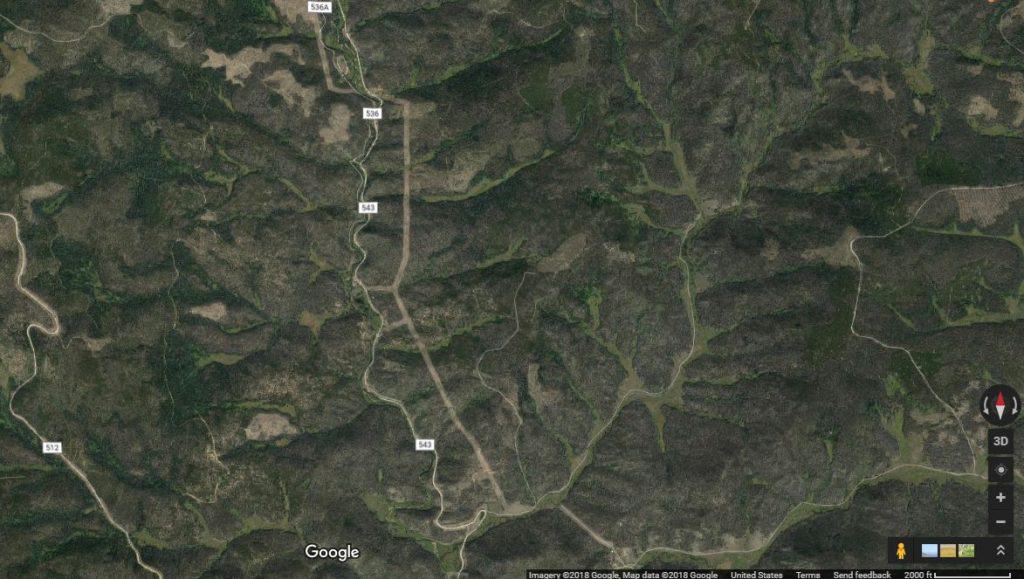
This is the second of two posts on the Washington Post story here about the Medicine Bow Landscape Vegetation Analysis LAVa project. All project information available here.
As to environmental groups, there’s a quote from Chris Topik, at The Nature Conservancy:
“If we are going to have a chance at combating climate change, forests are one of our best tools for mitigation because they sequester carbon,” said Chris Topik, director of the Nature Conservancy’s Restoring America’s Forests initiative. “So it’s vital that we help them to adapt.”
And then there’s the “science” angle. The story says “some biologists,” but only one is quoted.
Not everyone considers the plan a good idea. Some biologists say science does not back up the efficacy of the treatments proposed, particularly logging and the prescribed burns that the Forest Service calls necessary for lodgepole pine to reproduce and more diverse species to take root.
“They say they are going to reduce fuel loads to limit wildfires, and the literature doesn’t support that,” said Daniel B. Tinker, an associate professor at the University of Wyoming, who has studied the region for 23 years. “We’ve had fires this summer that burned through areas that were clear-cut 15 years ago. Those stands weren’t supposed to burn for 100 years.”
Reducing fuel loads, as we have seen, to change fire behavior and to provide opportunities for suppression forces to operate, are indeed supported by massive amounts of literature and the relatively humble fuels treatment effectiveness reports, as we have shown on this blog. Taking a look at Tinker’s recent pubs on the U of Wyo website here, doesn’t convince me that he’s an expert on wildfires nor fuels. But good one to the WaPo for interviewing someone local.
We can read this and instead think that conservation groups are divided on this.. first we have TNC, and then we have WEG.
Conservation groups also say that the Forest Service truncated scientific review in a rush to meet congressional demands for increased timber production on public lands. For now, the proposal does not specify which parcels would be targeted and where those hundreds of miles of road would be built.
“They are trying to fast-track this,” said Marla Fox, an attorney for WildEarth Guardians. “This is in line with the agency’s shift and approach under the Trump administration to ‘get out the cut,’ which means ‘let’s do some logging in the name of restoration.’ ”
NEPA-ites may chuckle at the use of “rush” when talking about an EIS. The article also says “Some pushback is internal. A group of Forest Service employees is skeptical that the agency can pull off an undertaking of this size.” Now I don’t doubt that many FS employees think different things, but this makes it sound like current employees are “pushing back” whatever that means. It sounds as if Andy polls a bunch of employees before he says anything, which I don’t think is the case (Andy?).
One more thing on this topic. Andy’s quote was that there is not enough money, which is of course probably true- but they’re setting the table, not guaranteeing a specific menu at a specific time. To my mind, the Med-Bow is not like the 4FRI at all. When I was working, I heard much about the ups and downs of industry in that area, and I admit that I don’t know what the story is currently. Still, I did see log trucks last summer there, so the industry is currently working. I might have interviewed someone from the industry on their situation, or Bill Crapser, the State Forester, if I had written the article or even NAFSR, the retiree organization. I suspect NAFSR would say something like:
“The U.S. Forest Service has been trying to move this direction for several years but has not yet been successful due to the novelty and technical complexity involved,” Andrew Larson, associate professor at the University of Montana, noted in an email. “If this project moves forward to implementation, it will become a case study in how to approach truly large-scale landscape planning and management.”
And what kind of professor is Dr. Larson, we might ask? Here’s some info. He’s also a forest ecologist. Which would mean that scientists (even within a sub-field) may not exactly agree with each other. Just like conservation groups and everyone else..

Increasing the Scope and Scale of Treatments- WaPo Story on the Medicine Bow Landscape Project- I of II
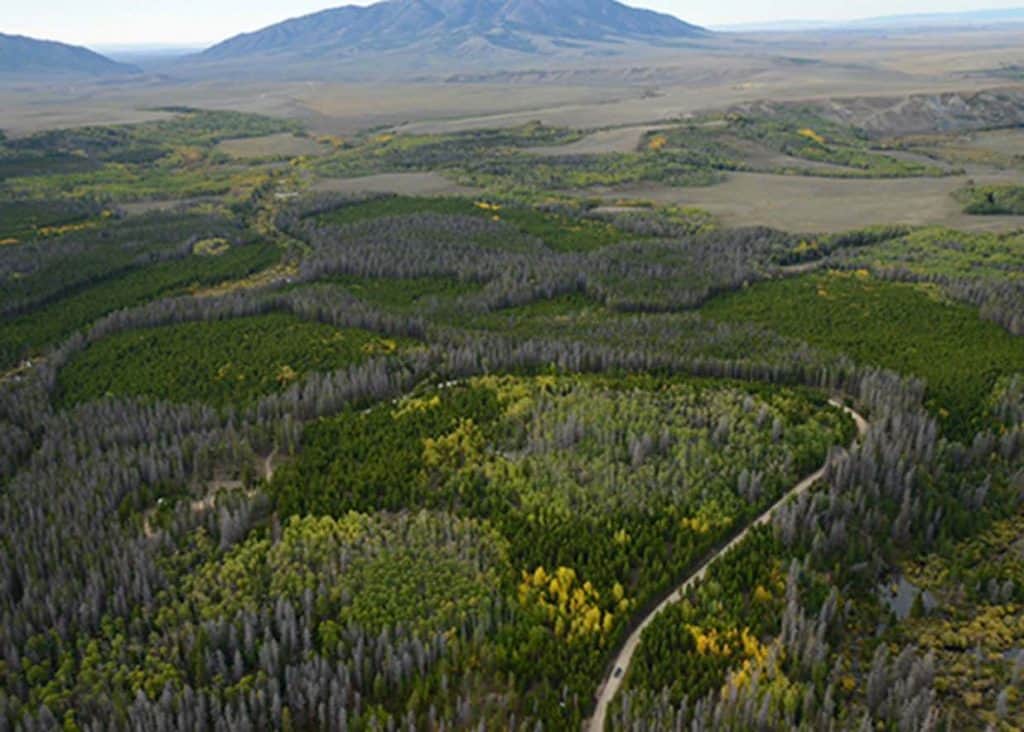
You don’t expect the Washington Post to take an interest in what’s going on in Wyoming, so this story was something of a surprise.
The take-home message is that forests are trying landscape-scale NEPA. We’ve heard from many scientists and others that we need to “increase the pace and scale of treatments to get fire back on the landscape.” So different sets of folks are trying that. People who don’t like CEs(categorical exclusions) should love these, one would think, because that’s exactly where projects and their interactions analyzed through space and time with a full EIS and all the appurtenances. In the somewhat, similar Black Hills Resilient Landscape Project, they added a multiparty monitoring effort so that findings toward the beginning could inform projects toward the end- that sounds great to me. Theoretically, this could be the perfect form of NEPA for ongoing vegetation management and prescribed burning programs.
This WaPo story is interesting for many reasons, and worthy of our attention because it reflects the intersection of concerns about how NEPA is done nd about doing land management actions. The story kind of shifts between the idea of “doing NEPA” and “whether treatments work” and “whether you can afford them.” I look at “doing big NEPA” as setting the NEPA table. You don’t know if the chef (Congress (not the President), the WO and your region) is going to give you one french fry, or a five-course gourmet meal with wine. You don’t know if the State or TNC or other partners will pop into the kitchen and fix a nice dessert. Now, if you are the chef, would you want to serve a dining room where tables were set or not?
The 15-year project, a marked departure from the agency’s historical approach to restoration, is moving forward as President Trump blames the deadliest wildfire in California’s history on “gross mismanagement of the forests” — a widely disputed allegation.
(It seems to be a WaPo standard along with the ever-present Democracy Dies in Darkness banner, that each story must somehow involve the narrative that Trump is bad. Of course, Trump’s statement might have been a reason to look into this topic for them, so maybe his tweets are having some positive benefits! My italics.)
The Trump administration’s shift to decades-long management plans encompassing vast stretches is in stark contrast to the Forest Service’s historical practice of grooming parcels of 3,000 to 10,000 acres over a period of months. In New Mexico, the agency is preparing an environmental report for the 185,586-acre Luna Restoration Project in the Gila National Forest. Work on the 179,054-acre La Garita Hills Restoration Project in Colorado’s Rio Grande National Forest is underway.
NEPA folks have been talking about “big gulp” project for many years. One concern was strategic.. bigger projects make bigger targets for folks who want to litigate them. In planning, we used to talk about the “flotilla of small boats” compared to the Queen Mary. If litigators want to be efficient with their time and energy, they would tend to go after big projects. I’m not sure if that is the reason, but many of these larger projects have been successful in areas where litigation is not so frequent. The Black Hills, Arizona, New Mexico, Colorado, Wyoming. There’s also the Blue Mountains Resiliency Project, started in 2015 with a link here. The sweet spot might be “where infrastructure still exists and litigation is not so frequent.”
As Andy mentions in his quote, 4FRI was also large-scale and started long before Trump. During the Obama Administration, I remember calls with CEQ in which CEQ asked EPA to stand down from their concerns about a large project on the Black Hills. Their point was that no changes to CEQ regs are needed, it is possible to do large projects with existing regs. In this case, it was indeed possible with high level support and inter-agency strong-arming when necessary. My point is that the pattern of going toward landscape-scale NEPA has been going on longer than the current Administration.
